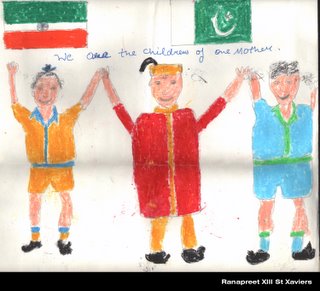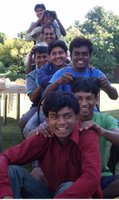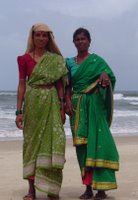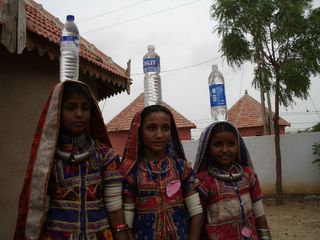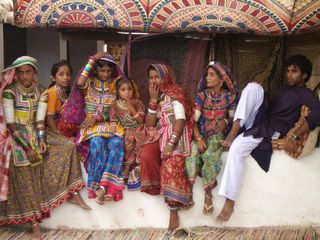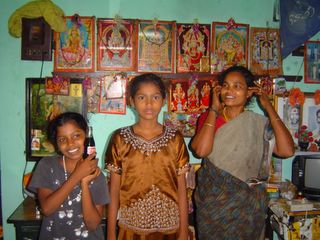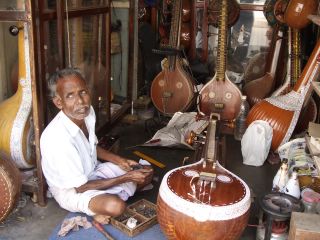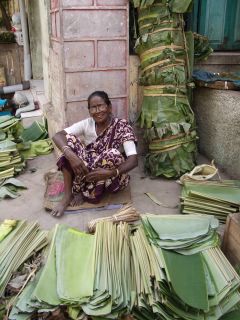I walk into a store in the vicinity of the hotel, and the selection -- a far cry from the standard Indian fare -- astounds me: bottles upon bottles of hair dye. Stacks of toilet paper. Rows of cosmetic apparel, each with its own superlative for “natural”. Packs of chocolate chip cookies, boxes of cereal, plastic-encased museli bars, and “natural” honey, strawberries, aloevera toe-cream..you name it. Outside the shop, I see two red-robed figures standing unceremoniously close. The tatooed, pierced man is wearing more beads than my grandmother owns, the bindied and kajaled woman is covering her naked shoulders and head by an outrageously bright dupatta. In foreign tongues, they are trying to get their message across. One says, “I like, I know you, I like, I like…” while the girl, pointing her finger at his chest, says in an equally thick accent, “I like you, you I….”
I feel like I’m in Willy Wonka’s crazy neverland. Well, I almost am. I suspect that there are few places in the world that come as close as Osho-world.
*************
Purely by chance, the hotel my colleague and I were staying at in Poona ended up being right next to the Osho International Meditation Resort. I arrived late on Sunday night on the hotel premises, only to find myself enshrouded in a ring of smoke and amongst a throng of dredlocked red-robed white-folk, who were sitting and lying comfortably close on the ground. With the hint of a snicker, the driver said, “Madame, Barista is here no, so this is only the place where all Osho people are coming.” The scene bewildered me, and I was almost tempted to find out more, but it was late, and the scene too strange, so I decided to call it a night.
The next day, 4am was heralded by “Om Hari Om” devotional songs, courtesy our pious neighbors. I left the hotel early, but was back by noon. Walking to my room, the bass-beats of a trance song greeted my steps. As I drew nearer, I realized that this wasn’t an unusually loud chanting session. There was a disco party happening somewhere. A disco party, at noon?! Straining to get a better glimpse through the grills, I witnessed one of the strangest sights I have ever seen: hundreds of red-robed men and women, were gyrating wildly to the rhythm, their heads swaying as if in a drunken stupor, their arms and legs moving as if by an invisible force. What was more, Osho had apparently ‘forgotten’ to lay down rules on the design of the robes, so interpretation of the design was limited solely by one’s imagination. In fact, if there actually was a dress-code, the spaghetti-strapped, tight-fitting, slitted robes that most women wore seemed to indicate that it was probably “Leave Nothing to the Imagination”.
I needed to get to the bottom of this, and find out if there really was something profound to this popular path to spiritual solace. The skin-showing, the strange dancing..it was all a bit weird, but I was willing to give it the benefit of the doubt. So I decided to take a walk over to the Resort to see for myself.
In the distance, I saw a couple -- man with fountain-like ponytail on top of his head, perfectly-manicured woman wearing a 'robe' that Nicole Kidman would envy -- locked in a frozen embrace near the entrance. A spiritual game of Freeze? I walked over to the entrance desk, only to be waved off by an irate desk attendant, similarly red-robe-clad, who was rolling his eyes at someone on the phone who was enquiring about rooms at the Resort. He thrust me a brochure and waved me to the side.
Brochure in hand, I stood on the side to get a better glimpse of Osho-traffic and to read what all this was about. Pearls of Osho wisdom lay triumphantly on the cover:
“What I am doing here is very simple, very ordinary, nothing spiritual in it, nothing sacred. I am not trying to make you holy persons. I am simply trying to make you sane, intelligent, ordinary people, who can live their lives joyously, dancingly, celebratingly.”
Hmm. I looked up, and chewed on my lip for second. The last time I checked, ‘dancingly’ and ‘celebratingly’ didn’t appear in my dictionary.
Well, I thought,
so what if Osho wasn’t the brightest star in the sky. I then opened the brochure only to find that visitors were only allowed on a Silent Tour between 9:30 to 11:30 am, and from 2 to 3 pm, for a cost-effective Rs. 10. Bookings a few days in advance were recommended. On the next page, I glimpsed the Meditation section, and was impressed. Maybe there was something to this after all. A second later, I did a double-take as I read the registration procedure:
1. AIDS test, Welcome morning and first day entrance fee. Nationals: Rs. 460; Internationals: Rs. 1180.
An AIDS test?
Enough said.
****************
I’ve wondered about people who come to India to “find themselves” while hopping from ashram to ashram, or who attempt to ayurvedayogamassagereiki their souls to spiritual perfection. Somehow, as the popularity of Osho’s Resort indicates, many want a spirituality that is not spiritual. Something extraordinary that’s ordinary. Something to justify, even encourage, profligate habits. We want someone to tell us that what we seek lies outside, to save us from the difficult task of looking within ourselves.
Of course, I understand that each of us wants to be the best that we can be. But at the cost of leaving a mountain of waste in one’s wake? During the course of my travels, I have met many who, having taken innumerable yoga classes at a lavish Goa/Varkala beach resort, praise the beauty of “my land” and ask me wonderously to elaborate on “my culture”, all the while reaching for a plastic-encased croissant and sipping a plastic cup of Barista coffee. In situations like these, I brush over a few points about my experiences in India, but usually make it a point to hint at the plastic bottle-saving tactic of drinking fresh fruit juice, or encourage people to try local, fresh fare both to encourage local industry and to minimize waste.
This is not to say that Indians don’t waste. But on average, an Indian lifestlye is usually far more resource-efficient than a Western one, usually driven by necessity and habit. I have usually made a quick but polite getaway from conversations such as the one above. But I think I’ll be more truthful next time someone asks. Maybe I will say:
India is indeed one among the most beautiful lands.
But if you want to help preserve it,
Do away with the plastic bottles and toilet paper,
For the power is in your hands.
